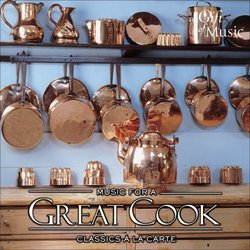| All Artists: Various Title: Music for a Great Cook Members Wishing: 0 Total Copies: 0 Label: The Gift of Music Original Release Date: 1/1/2005 Re-Release Date: 3/4/2005 Genre: Classical Style: Symphonies Number of Discs: 1 SwapaCD Credits: 1 UPC: 658592113327 |
Search - Various :: Music for a Great Cook
 | Various Music for a Great Cook Genre: Classical
Music for a Great Cook - Classics à la carte Cheerful music to cook by, featuring some of the best Baroque music ever! Put this album on in the kitchen, and let the inspiration fall upon you as you chop and grind, boi... more » |
Larger Image |
CD Details
Synopsis
Product Description
Music for a Great Cook - Classics à la carte Cheerful music to cook by, featuring some of the best Baroque music ever! Put this album on in the kitchen, and let the inspiration fall upon you as you chop and grind, boil and fry! Twenty-one tasty tracks to add an extra flavour to your méthode de cuisine! When is a kitchen not a kitchen? For more than a thousand years, such words as kycchen, ketching and cycene have meant the part of a house where the cooking was done. In fact, for most of this lengthy period, the cooking was invariably done over a fire in an unbuilt space with no venting. For most, a 'kitchen' was a selected area in a single roomed home. Apart from cooking, it provided, amongst other things, warmth, hot water and a degree of lighting. This primitive process was far removed from the vast, sometimes palatial, kitchens that the affluent families would have. Houses owned by the nobility had kitchens that were responsible for providing a wide variety of foods, usually on a grand scale and they would be located in far removed, specially designated areas, such as the outlying wings of the house. When Cardinal Wolsey began to extend Hampton Court in 1514, one of his first tasks was to build kitchens that catered for his household of some 600. However, arrangements that suited the Cardinal would prove to be too small for Henry VIII's own household of 1200 people. In 1529, Henry started to extend the kitchens to provide a 36,000 square feet cooking area. An example of what these kitchens could prepare was the feast of John the Baptist celebrated on Midsummer's Day in 1542. On special occasions such as this, the quantity and quality of the food served was increased and included venison pie, baked carp in wine and prunes, peacock royal, creamed almonds and stuffed boar in a sauce. The kitchens served the royal court until 1660, when the servants, having lost the privilege of dining at the king's table, were given a salary instead. The kitchens consisted of a vast complex of some 50 rooms, approached from the main entrance by a separate gatehouse, which today is the Seymour Gate. All supplies for the court were brought through here. Above the gateway the Board of the Greencloth met and this oddly named body was responsible for the kitchens' administration and monitored the produce that came in and out of the Palace. The kitchens were divided into 15 or so separate offices, or sub-departments, such as the Spicery (which stored a wide array of spices), the Confectory (which housed sweets and pastries) and the Pastry (where the pastry cases and crusts were made). Each office was allocated rooms around the various kitchen courtyards - downstairs, staff undertook their duties and upstairs were their sleeping quarters. The rooms of only one office survive today, the Office of the Boiling House, which provided boiled meat and stock. A long narrow courtyard, known as Fish Court, connected several of these offices, including meat and fish larders. The fish larder stored saltwater fish brought from the coast in barrels with seaweed. Freshwater fish were kept alive in the palace ponds until they were required. The food was assembled in the three rooms of the Great Kitchens and then passed through hatches before being taken upstairs to the awaiting courtiers. These kitchens were under the control of the Master Cook who had some 12 other cooks with a further 12 or so assistants. The court drank about 300 barrels of ales a year and an almost equal quantity of wine, which were stored in three cellars. Whatever your kitchen size, we hope that you enjoy your meal to the accompaniment of this satisfying and calorie-free programme.

 Track Listings (21) - Disc #1
Track Listings (21) - Disc #1